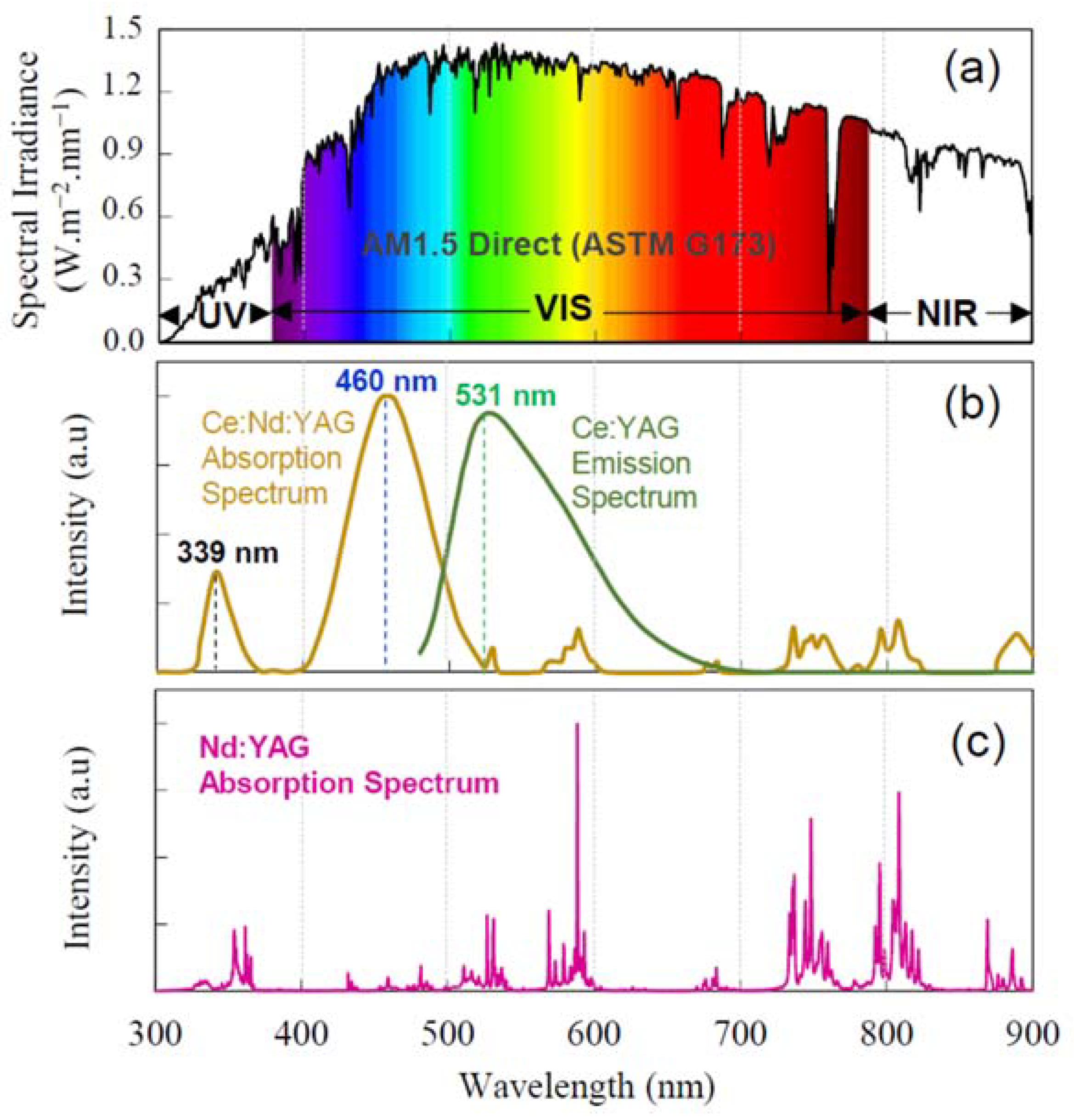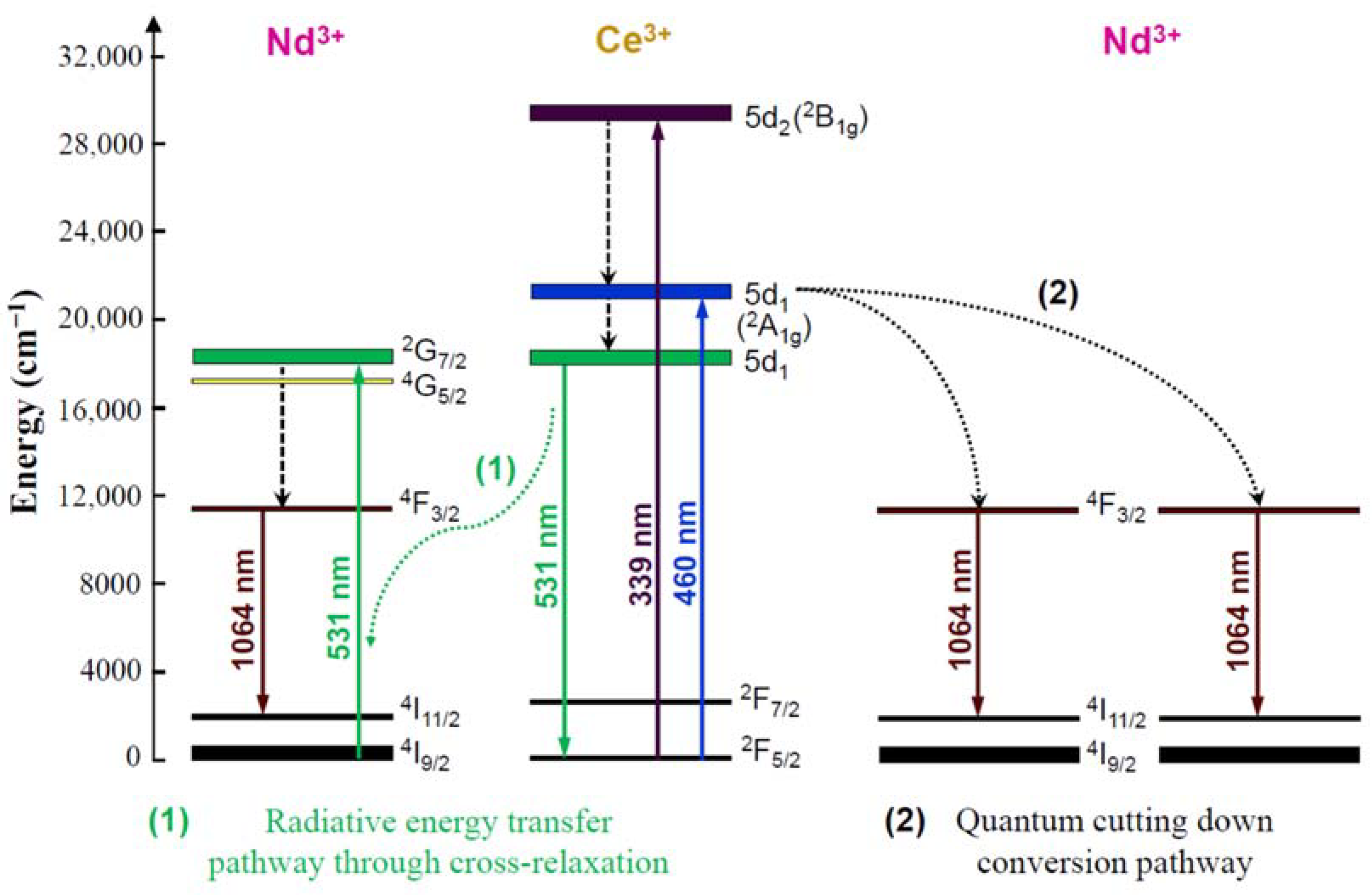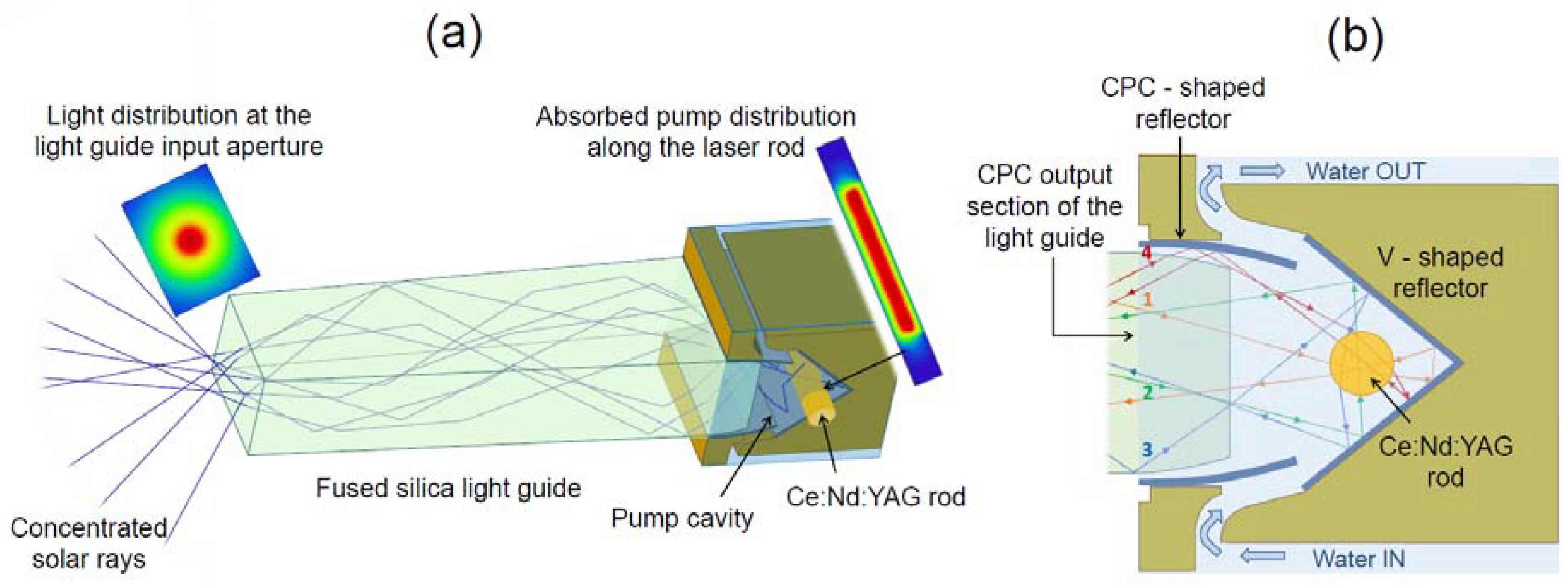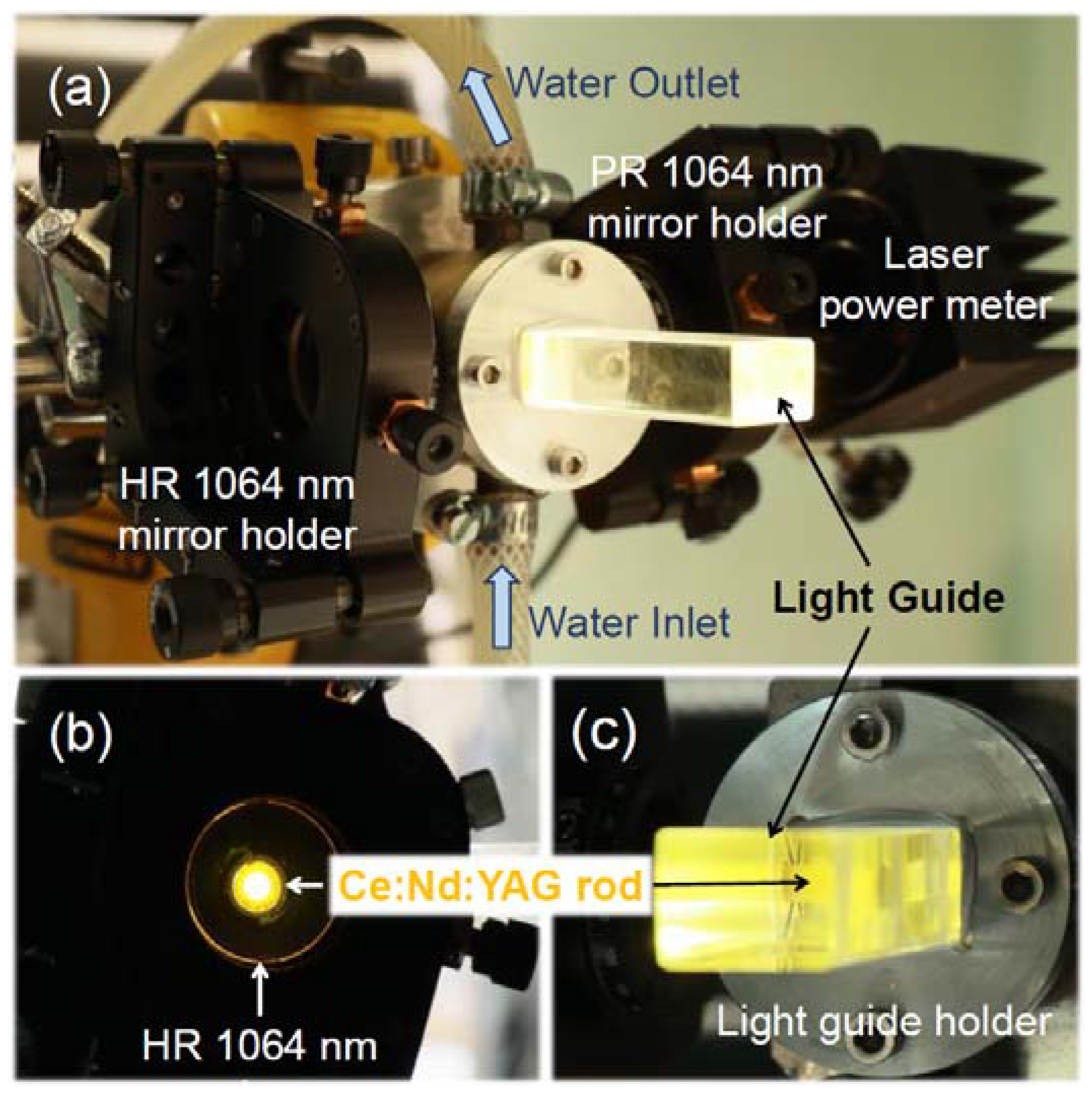40 W Continuous Wave Ce:Nd:YAG Solar Laser through a Fused Silica Light Guide
Abstract
:1. Introduction
2. Energy Transfer Mechanism of Ce3+ to Nd3+ in Ce:Nd:YAG Medium
3. Description of the Ce:Nd:YAG Solar Laser System
3.1. Medium Size Solar Furnace of the PROMES-CNRS
3.2. Side-Pumped Solar Laser Head with the Fused Silica Homogenizer
4. Solar-Pumped Ce:Nd:YAG Laser Experiments with the Rectangular Fused Silica Light Guide
5. Conclusions
Author Contributions
Funding
Institutional Review Board Statement
Informed Consent Statement
Data Availability Statement
Acknowledgments
Conflicts of Interest
References
- The Global Goals, Goal 7: Affordable and Clean Energy. Available online: https://www.globalgoals.org/goals/7-affordable-and-clean-energy/ (accessed on 1 April 2022).
- The Global Goals, Goal 9: Industry, Innovation and Infrastructure. Available online: https://www.globalgoals.org/goals/9-industry-innovation-and-infrastructure/ (accessed on 1 April 2022).
- Yabe, T.; Bagheri, B.; Ohkubo, T.; Uchida, S.; Yoshida, K.; Funatsu, T.; Oishi, T.; Daito, K.; Ishioka, M.; Yasunaga, N.; et al. 100 W-class solar pumped laser for sustainable magnesium-hydrogen energy cycle. J. Appl. Phys. 2008, 104, 083104. [Google Scholar] [CrossRef]
- Motohiro, T.; Takeda, Y.; Ito, H.; Hasegawa, K.; Ikesue, A.; Ichikawa, T.; Higuchi, K.; Ichiki, A.; Mizuno, S.; Ito, T.; et al. Concept of the solar-pumped laser-photovoltaics combined system and its application to laser beam power feeding to electric vehicles. Jpn. J. Appl. Phys. 2017, 56, 08MA07. [Google Scholar] [CrossRef]
- Abdel-Hadi, Y.A. Space-based solar laser system simulation to transfer power onto the earth. NRIAG J. Astron. Geophys. 2020, 9, 558–562. [Google Scholar] [CrossRef]
- Weaver, W.R.; Lee, J.H. A Solar Pumped Gas Laser for the Direct Conversion of Solar Energy. J. Energy 1983, 7, 498–501. [Google Scholar] [CrossRef]
- Kiss, Z.J.; Lewis, H.R.; Duncan, R.C. Sun pumped continuous optical maser. Appl. Phys. Lett. 1963, 2, 93–94. [Google Scholar] [CrossRef]
- Insuik, R.J.; Christiansen, W.H. Blackbody-pumped CO2 laser experiment. AIAA J. 1984, 22, 1271–1274. [Google Scholar] [CrossRef]
- Terry, C.K.; Peterson, J.E.; Goswami, D.Y. Terrestrial solar-pumped iodine gas laser with minimum threshold concentration requirements. J. Thermophys. Heat Transf. 1996, 10, 54–59. [Google Scholar] [CrossRef]
- Lee, J.H.; Kim, K.C.; Kim, K.H. Threshold pump power of a solar-pumped dye laser. Appl. Phys. Lett. 1988, 53, 2021–2022. [Google Scholar] [CrossRef]
- Arashi, H.; Oka, Y.; Sasahara, N.; Kaimai, A.; Ishigame, M. A Solar-Pumped cw 18 W Nd:YAG Laser. Jpn. J. Appl. Phys. 1984, 23, 1051–1053. [Google Scholar] [CrossRef]
- Weksler, M.; Shwartz, J. Solar-pumped solid-state lasers. IEEE J. Quantum Electron. 1988, 24, 1222–1228. [Google Scholar] [CrossRef]
- Lando, M.; Kagan, J.; Linyekin, B.; Dobrusin, V. A solar-pumped Nd:YAG laser in the high collection efficiency regime. Opt. Commun. 2003, 222, 371–381. [Google Scholar] [CrossRef]
- Dinh, T.H.; Ohkubo, T.; Yabe, T.; Kuboyama, H.J.O.L. 120 watt continuous wave solar-pumped laser with a liquid light-guide lens and an Nd:YAG rod. Opt. Lett. 2012, 37, 2670–2672. [Google Scholar] [CrossRef] [PubMed]
- Liang, D.; Almeida, J. Highly efficient solar-pumped Nd:YAG laser. Opt. Express 2011, 19, 26399–26405. [Google Scholar] [CrossRef] [PubMed]
- Liang, D.; Almeida, J.; Vistas, C.R.; Guillot, E. Solar-pumped Nd:YAG laser with 31.5W/m2 multimode and 7.9W/m2 TEM00-mode collection efficiencies. Sol. Energy Mater. Sol. Cells 2017, 159, 435–439. [Google Scholar] [CrossRef]
- Guan, Z.; Zhao, C.; Li, J.; He, D.; Zhang, H. 32.1 W/m2 continuous wave solar-pumped laser with a bonding Nd:YAG/YAG rod and a Fresnel lens. Opt. Laser Technol. 2018, 107, 158–161. [Google Scholar] [CrossRef]
- Guan, Z.; Zhao, C.; Zhang, H.; Li, J.; He, D.; Almeida, J.; Vistas, C.R.; Liang, D. 5.04% system slope efficiency solar-pumped Nd:YAG laser by a heliostat-parabolic mirror system. J. Photonics Energy 2018, 8, 2. [Google Scholar] [CrossRef]
- Liang, D.; Almeida, J.; Garcia, D.; Tibúrcio, B.D.; Guillot, E.; Vistas, C.R. Simultaneous solar laser emissions from three Nd:YAG rods within a single pump cavity. Sol. Energy 2020, 199, 192–197. [Google Scholar] [CrossRef]
- Almeida, J.; Liang, D.; Guillot, E. Improvement in solar-pumped Nd:YAG laser beam brightness. Opt. Laser Technol. 2012, 44, 2115–2119. [Google Scholar] [CrossRef]
- Almeida, J.; Liang, D.; Vistas, C.R.; Bouadjemine, R.; Guillot, E. 5.5 W continuous-wave TEM00-mode Nd:YAG solar laser by a light-guide/2V-shaped pump cavity. Appl. Phys. B 2015, 121, 473–482. [Google Scholar] [CrossRef]
- Liang, D.; Almeida, J.; Guillot, E. Side-pumped continuous-wave Cr:Nd:YAG ceramic solar laser. Appl. Phys. B Lasers Opt. 2013, 111, 305–311. [Google Scholar] [CrossRef]
- Yabe, T.; Ohkubo, T.; Uchida, S.; Yoshida, K.; Nakatsuka, M.; Funatsu, T.; Mabuti, A.; Oyama, A.; Nakagawa, K.; Oishi, T.; et al. High-efficiency and economical solar-energy-pumped laser with Fresnel lens and chromium codoped laser medium. Appl. Phys. Lett. 2007, 90, 261120. [Google Scholar] [CrossRef]
- Liang, D.; Vistas, C.R.; Tibúrcio, B.D.; Almeida, J. Solar-pumped Cr:Nd:YAG ceramic laser with 6.7% slope efficiency. Sol. Energy Mater. Sol. Cells 2018, 185, 75–79. [Google Scholar] [CrossRef]
- Vistas, C.R.; Liang, D.; Garcia, D.; Almeida, J.; Tibúrcio, B.D.; Guillot, E. Ce:Nd:YAG continuous-wave solar-pumped laser. Optik 2020, 207, 163795. [Google Scholar] [CrossRef]
- Vistas, C.; Liang, D.; Almeida, J.; Tibúrcio, B.; Garcia, D.; Catela, M.; Costa, H.; Guillot, E. Ce:Nd:YAG side-pumped solar laser. J. Photonics Energy 2021, 11, 018001. [Google Scholar] [CrossRef]
- Vistas, C.R.; Liang, D.; Garcia, D.; Catela, M.; Tibúrcio, B.D.; Costa, H.; Guillot, E.; Almeida, J. Uniform and Non-Uniform Pumping Effect on Ce:Nd:YAG Side-Pumped Solar Laser Output Performance. Energies 2022, 15, 3577. [Google Scholar] [CrossRef]
- Lupei, V.; Lupei, A.; Gheorghe, C.; Ikesue, A. Emission sensitization processes involving Nd3+ in YAG. J. Lumin. 2016, 170, 594–601. [Google Scholar] [CrossRef]
- Saiki, T.; Uchida, S.; Imasaki, K.; Motokoshi, S.; Yamanaka, C.; Fujita, H.; Nakatsuka, M.; Izawa, Y. Oscillation Property of Disk-Type Nd/Cr:YAG Ceramic Lasers with Quasi-Solar Pumping, (CLEO). In Proceedings of the Lasers and Electro-Optics, Baltimore, MD, USA, 22–27 May 2005; Volume 2, pp. 915–917. [Google Scholar]
- Yagi, H.; Yanagitani, T.; Yoshida, H.; Nakatsuka, M.; Ueda, K. The optical properties and laser characteristics of Cr3+ and Nd3+ co-doped Y3Al5O12 ceramics. Opt. Laser Technol. 2007, 39, 1295–1300. [Google Scholar] [CrossRef]
- Payziyev, S.; Makhmudov, K.; Abdel-Hadi, Y.A. Simulation of a new solar Ce:Nd:YAG laser system. Optik 2018, 156, 891–895. [Google Scholar] [CrossRef]
- Payziyev, S.; Sherniyozov, A.; Bakhramov, S.; Zikrillayev, K.; Khalikov, G.; Makhmudov, K.; Ismailov, M.; Payziyeva, D. Luminescence sensitization properties of Ce:Nd:YAG materials for solar pumped lasers. Opt. Commun. 2021, 499, 127283. [Google Scholar] [CrossRef]
- Mares, J.; Jacquier, B.; Pédrini, C.; Boulon, G.J.R.P.A. Energy transfer mechanisms between Ce3+ and Nd3+ in YAG: Nd, Ce at low temperature. Rev. Phys. Appliquée 1987, 22, 145–152. [Google Scholar] [CrossRef]
- Meng, J.X.; Li, J.Q.; Shi, Z.P.; Cheah, K.W. Efficient energy transfer for Ce to Nd in Nd/Ce codoped yttrium aluminum garnet. Appl. Phys. Lett. 2008, 93, 221908. [Google Scholar] [CrossRef]
- Tai, Y.; Zheng, G.; Wang, H.; Bai, J. Near-infrared quantum cutting of Ce3+–Nd3+ co-doped Y3Al5O12 crystal for crystalline silicon solar cells. J. Photochem. Photobiol. A Chem. 2015, 303–304, 80–85. [Google Scholar] [CrossRef]
- Guo, Y.; Huang, J.; Ke, G.; Ma, Y.; Quan, J.; Yi, G. Growth and optical properties of the Nd,Ce:YAG laser crystal. J. Lumin. 2021, 236, 118134. [Google Scholar] [CrossRef]
- Villars, B.; Steven Hill, E.; Durfee, C.G. Design and development of a high-power LED-pumped Ce:Nd:YAG laser. Opt. Lett. 2015, 40, 3049–3052. [Google Scholar] [CrossRef] [PubMed] [Green Version]
- Samuel, P.; Yanagitani, T.; Yagi, H.; Nakao, H.; Ueda, K.I.; Babu, S.M. Efficient energy transfer between Ce3+ and Nd3+ in cerium codoped Nd: YAG laser quality transparent ceramics. J. Alloys Compd. 2010, 507, 475–478. [Google Scholar] [CrossRef]
- ASTM G173-03; Standard Tables for Reference Solar Spectral Irradiances: Direct Normal and Hemispherical on 37° Tilted Surface. ASTM International: West Conshohocken, PA, USA, 2012.
- Nishiura, S.; Tanabe, S.; Fujioka, K.; Fujimoto, Y. Properties of transparent Ce: YAG ceramic phosphors for white LED. Opt. Mater. 2011, 33, 688–691. [Google Scholar] [CrossRef]
- Prahl, S. Nd:YAG—Nd:Y3Al5O12. Available online: https://omlc.org/spectra/lasermedia/html/052.html (accessed on 1 April 2022).
- Liu, X.; Teng, Y.; Zhuang, Y.; Xie, J.; Qiao, Y.; Dong, G.; Chen, D.; Qiu, J. Broadband conversion of visible light to near-infrared emission by Ce3+, Yb3+-codoped yttrium aluminum garnet. Opt. Lett. 2009, 34, 3565–3567. [Google Scholar] [CrossRef]
- PROMES-CNRS Solar Furnaces and Concentrating Solar Systems. Available online: https://www.promes.cnrs.fr/en/infrastructure-solaire/moyens-solaires/solar-furnaces-and-concentrating-solar-systems/ (accessed on 1 April 2022).
- Heraeus Properties of Fused Silica. Available online: https://www.heraeus.com/en/hca/fused_silica_quartz_knowledge_base_1/properties_1/properties_hca.html (accessed on 1 April 2022).
- Mehellou, S.; Liang, D.; Almeida, J.; Bouadjemine, R.; Vistas, C.R.; Guillot, E.; Rehouma, F. Stable solar-pumped TEM00-mode 1064 nm laser emission by a monolithic fused silica twisted light guide. Sol. Energy 2017, 155, 1059–1071. [Google Scholar] [CrossRef]






| Collection Diameter, D | D = 1.38 m | D = 1.60 m | D = 1.78 m | D = 2.00 m |
|---|---|---|---|---|
| Rim angle, α | 44° | 50° | 55° | 60° |
| Effective collection area | 1.09 m2 | 1.53 m2 | 1.93 m2 | 2.48 m2 |
| Maximum incoming solar power | 1154 W | 1559 W | 2033 W | 2600 W |
| Minimum threshold solar power | 578 W | 657 W | 795 W | 943 W |
| Maximum laser output power | 17.35 W | 25.13 W | 31.80 W | 40.01 W |
| Slope efficiency | 3.01% | 2.78% | 2.59% | 2.44% |
| M2x, M2y factors | 38, 38 | --- | --- | 52, 54 |
Publisher’s Note: MDPI stays neutral with regard to jurisdictional claims in published maps and institutional affiliations. |
© 2022 by the authors. Licensee MDPI, Basel, Switzerland. This article is an open access article distributed under the terms and conditions of the Creative Commons Attribution (CC BY) license (https://creativecommons.org/licenses/by/4.0/).
Share and Cite
Almeida, J.; Liang, D.; Garcia, D.; Tibúrcio, B.D.; Costa, H.; Catela, M.; Guillot, E.; Vistas, C.R. 40 W Continuous Wave Ce:Nd:YAG Solar Laser through a Fused Silica Light Guide. Energies 2022, 15, 3998. https://doi.org/10.3390/en15113998
Almeida J, Liang D, Garcia D, Tibúrcio BD, Costa H, Catela M, Guillot E, Vistas CR. 40 W Continuous Wave Ce:Nd:YAG Solar Laser through a Fused Silica Light Guide. Energies. 2022; 15(11):3998. https://doi.org/10.3390/en15113998
Chicago/Turabian StyleAlmeida, Joana, Dawei Liang, Dário Garcia, Bruno D. Tibúrcio, Hugo Costa, Miguel Catela, Emmanuel Guillot, and Cláudia R. Vistas. 2022. "40 W Continuous Wave Ce:Nd:YAG Solar Laser through a Fused Silica Light Guide" Energies 15, no. 11: 3998. https://doi.org/10.3390/en15113998
APA StyleAlmeida, J., Liang, D., Garcia, D., Tibúrcio, B. D., Costa, H., Catela, M., Guillot, E., & Vistas, C. R. (2022). 40 W Continuous Wave Ce:Nd:YAG Solar Laser through a Fused Silica Light Guide. Energies, 15(11), 3998. https://doi.org/10.3390/en15113998








